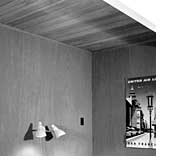Eichler Interior Paneling
 Interior walls covered in Philippine mahogany paneling are a distinctive and essential feature of an Eichler home, though by the early 1960s they had begun to give way to sheet rock for cost or code safety reasons. With mid-century modern once again back in style, Eichler owners whose paneling has long since been covered over with multiple layers of paint (or worse!) are on the prowl for used paneling or scouring lumberyards to find a suitable modern equivalent that will restore their home to its glorious youth.
Interior walls covered in Philippine mahogany paneling are a distinctive and essential feature of an Eichler home, though by the early 1960s they had begun to give way to sheet rock for cost or code safety reasons. With mid-century modern once again back in style, Eichler owners whose paneling has long since been covered over with multiple layers of paint (or worse!) are on the prowl for used paneling or scouring lumberyards to find a suitable modern equivalent that will restore their home to its glorious youth.
One approach that is sometimes attempted is to flip the old paneling and use the back side (veneer originally was applied to both sides). Generally the paneling is easy to remove, but it can be difficult to reapply, since decades-old wood-framed houses tend to go out of true; the corners oftentimes aren't square any more. Leaving that problem aside, if you are lucky enough to find the back of the paneling clean and not discolored, the problem then becomes the cutouts for the power outlets and switches. Ambitious homeowners have actually moved outlets and switches so they will conform to the new cutout positions. (Tip: For discolored paneling, wash with a TSP or diluted-bleach solution, and then use fine sandpaper to attempt removal of marks, being careful not to sand through the veneer.)
This may all seem like far too much work for some people. Why not just buy new paneling? When calling lumberyards to source it, keep in mind that although Eichler sales brochures promoted the paneling as "Philippine mahogany," it's generally known these days as "luan paneling". You can purchase it in quantity for as little as $10 a 4-foot x 8-foot sheet delivered. At that price it hardly seems worthwhile to attempt restoration of old paneling, even though the modern equivalent isn't necessarily up to the quality of the original. If you need panels taller than eight feet, they don't seem to be available, so used panels may be your only option.
Homeowner Jim Herold, who rebuilt his Sunnyvale Eichler from the ground up after a devastating fire, found that the luan paneling he sourced didn't meet his personal quality standards; he was rejecting more than he was keeping. He is currently evaluating Honduran mahogany paneling, but at $74 per sheet this is not a realistic option for everyone.
Paneling comes in a range of thicknesses. Eichler used quarter-inch, but this presents yet another problem for modern-day restorers: finding quarter-rounds, the rounded trim used to finish edges, in the ideal size. It's not a stock item. Lumberyards will make it to order, though the price to finish one eight-foot edge can exceed the cost of paneling an entire room. And don't forget about mahogany baseboards; you'll need them in a plain style, which is difficult to find. Consider cutting your own with a table saw from mahogany stock.
Once you've got a stack of new paneling ready to go, the real work begins: cutting and fitting each panel into an area that may no longer have true right-angle corners. Consider using a nail gun to avoid hammer marks made when setting the finishing nails.
Finally, it should be pointed out that modern building codes may prohibit the use of wood veneer paneling alone on interior walls for fire safety reasons. Horror stories about Eichlers as "ten-minute burns" are in part due to the flammability of the paneling. General contractor and Eichler specialist Ron Key recommends using sheet rock under paneling to conform to local codes regarding allowable interior wall materials. In his opinion, sheet rock is low-cost insurance. He also suggests limiting paneling to one or two walls so the room isn't too dark.
The issue of paneling and fire safety is a serious one, but if your Eichler still has all its original paneling, don't panic. It's important to keep the true risk of fire in mind. Deaths from home fires in this country are a small fraction of highway fatalities, to cite just one example. Installing smoke detectors throughout the house, and checking them periodically, as well as placing fire extinguishers in key locations, are low-cost steps that all homeowners should take. They won't stop fires from starting—most home fires are due to faulty heaters, cooking equipment, and careless smoking—but they can make all the difference when it comes to survival.




